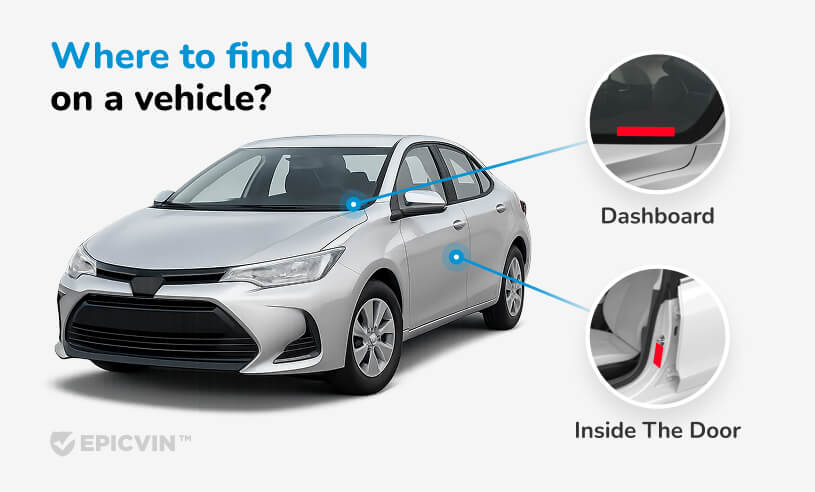
How to Read a VIN Number Like a Pro
From understanding the VIN number breakdown to uncovering a vehicle’s history,...

Free Tesla VIN Decoder! 🚗 See specs, build sheet, recalls basic history—no sign-up. 🛡️✅ Need accidents, mileage, title? Upgrade in one click.
Looking for the VIN?
Here is there you’ll find it:

Every Tesla vehicle features a unique 17-character vehicle identification number (VIN). It contains crucial manufacturing information. Our VIN decoder instantly translates each digit. Users can determine car authenticity, check specs, and uncover hidden history. Invalid VIN entries are rejected immediately, while invalid sequences trigger error messages to prevent data corruption.
Getting your Tesla's complete history is simple with our decoder system.

Your Tesla VIN is located in several key areas for easy reference and verification.
| Risk Factor | Percentage |
|---|---|
| Accident History Share | ≈ 28% of EpicVIN Tesla reports contain ≥ 1 damage record |
| Salvage/Rebuild Title | ≈ 24% of all Tesla vehicles listed on Copart have salvage or non-repairable status (1,113 of 4,667 lots sampled) |
| Average Mileage | ≈ 105,000 miles for Tesla vehicles older than 10 years. Model 3 and Y typically accumulate ~11,000–12,000 miles annually, while Model S averages ~8,300 miles |
| Active Recall Campaigns 2025 | During the first 3 months of 2025, Tesla initiated 3 major campaigns affecting ≈ 661,000 vehicles: 239k rear camera failures (Jan 10), 376k power steering issues (Feb 21), 46k Cybertruck trim detachment (Mar 20) |
| Failure Type | Statistics and Problem Details |
|---|---|
| Central Touchscreen Failure (MCU) | In 2021, Tesla recalled ≈ 135,000 Model S (2012-2018) and Model X (2016-2018) due to 8GB eMMC memory degradation. Screens were disabled, eliminating rearview camera access, climate control, and audio alerts. |
| Weak Suspension/Steering Arms | Between January 2021 and March 2022, the company replaced ≈ 120,000 upper suspension arms. It was due to premature corrosion and failures. Documented cases included wheel detachment and loss of control even below 15,000 miles. |
| Autopilot "Phantom" Braking | Since 2022, the NHTSA has investigated sudden unintended braking incidents. A class-action lawsuit approved by a Chicago court in November 2024 affects 2016-2024 Model S/X/3/Y vehicles. 2.4 million cars have been affected. |

Each letter and digit tells a specific story. Here's the standard VIN format, uncovering the car's production specs:
Here's a sample sequence for our Tesla VIN decoder to interpret (5YJSA1E25MF001234) :
| Symbols | Sample | What It Reveals |
|---|---|---|
| 1 | 5 | The USA as the country of manufacture |
| 2 | Y | Tesla as a manufacturer |
| 3 | J | Passenger car vehicle type |
| 4-8 | SA1E2 | Model S body type, long-range battery size, dual motor/chassis configuration, and restraint system |
| 9 | 5 | Check digit for validation |
| 10 | M | 2021 model year (year digit) |
| 11 | F | Fremont, California assembly plant |
| 12-17 | 001234 | Individual vehicle sequence number |
Year 2017
Make Tesla
Model Model S
Fuel Type Electric
Engine
Made in USA
Our Tesla VIN decoder reveals comprehensive car information from the sequence. We value complete accuracy in every report.
Before you snap up a used Tesla, drop the VIN into EpicVIN first. In seconds, you'll see the original build specs, mileage rollbacks, Autopilot- or battery-pack-related recalls, and any salvage or lien issues—solid facts that can save you a fortune.Alex Black, CMO & auto expert, EpicVIN
Yes. EpicVIN lets you run a basic Tesla VIN decode at no cost—you'll see build information, such as model (Model 3, Y, S, X, or Cybertruck), trim, motor type, and plant location. You pay only for the full report.
Our VIN decoder reads virtually every Tesla. This includes Model S sedans, Model X SUVs, Model 3, and Model Y crossovers. Roadsters and Cybertrucks can also be analyzed. Our VIN decoder can process any VIN with a standard format.
Enter the VIN in EpicVIN; review the "Recalls" section. We query NHTSA in real time, so open campaigns show up with recall numbers.
Yes. Specific characters reveal motor count (single vs dual motor), battery architecture, and build plant. EpicVIN's full report confirms the exact battery size and hardware version.
We sync daily with DMV records, NMVTIS, auctions, and Tesla recall feeds. New VINs appear in our system within 24 hours. Contact our support team for assistance or contact us for premium report options.
Discover expert tips, news and advice on buying and maintaining used vehicles

From understanding the VIN number breakdown to uncovering a vehicle’s history,...

By following these tips, you will get a great deal on a used car.

Many people buy cars before they ever get a license. If you're planning to do...